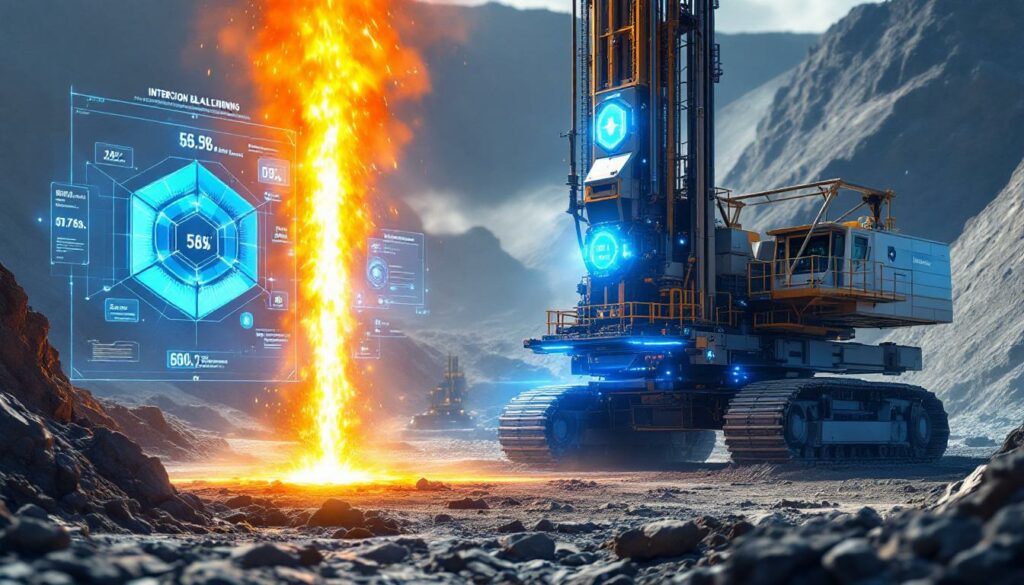The Evolution of Drill Assist: From Innovation to Hexagon Integration
Drill Assist technology represents a revolutionary advancement in mining operations, transforming how mining companies approach blasthole drilling. This sophisticated system has journeyed from an innovative concept to becoming an integral component of Hexagon's comprehensive mining solutions portfolio. Let's explore Drill Assist's long road to Hexagon and its impact on the mining industry.
What is Drill Assist Technology?
Understanding Automated Blasthole Drilling
Drill Assist technology fundamentally changes blasthole drilling through intelligent automation systems that enhance drilling precision and efficiency beyond human capabilities. Unlike traditional manual drilling operations, Drill Assist employs advanced algorithms and sensor technologies to optimize drilling parameters in real-time, resulting in more consistent hole quality and improved operational efficiency.
The technology works by continuously monitoring drilling conditions and automatically adjusting penetration rates, rotation speeds, and air pressure to maintain optimal performance regardless of geological variations. This adaptive capability ensures consistent drilling quality even in complex and variable ground conditions.
One of Drill Assist's most significant advantages is its universal compatibility. The system was engineered to interface with various drill types and manufacturers, offering mining operations a flexible solution that doesn't require complete fleet replacement.
Key Features and Capabilities
Drill Assist's technological framework provides several game-changing capabilities:
- Universal compatibility with multiple drill platforms from different manufacturers
- Automated parameter optimization that improves drilling speed by 15-30% compared to manual operation
- High-precision hole placement with accuracy improvements of up to 40%
- Real-time geological sensing that adjusts to changing ground conditions
- Seamless integration with existing fleet management systems
- Data collection and analysis for continuous performance improvement
- Reduced operator fatigue through automation of repetitive tasks
These features combine to create a system that not only improves individual drilling operations but also enhances the entire mining value chain through better blasting outcomes and downstream processing efficiencies.
How Did Drill Assist Begin Its Journey?
The Early Development Phase
Drill Assist's development originated from Curtis Stacy's vision to address fundamental inefficiencies in blasthole drilling operations. In the early 2010s, Stacy observed that while mining equipment had grown increasingly sophisticated, drilling processes still relied heavily on operator skill and manual adjustments, creating inconsistencies that affected overall mining productivity.
The initial development team faced significant challenges in creating a system that could adapt to different drilling platforms while delivering consistent performance improvements. Their approach focused on developing a modular architecture that could interface with various drill control systems without requiring extensive modifications to existing equipment.
The team's breakthrough came with the development of an adaptive control algorithm that could learn from operational data and continuously improve drilling performance. This machine learning component became the cornerstone of Drill Assist's ability to optimize drilling parameters across different geological conditions.
First Field Trials and Testing
Initial field testing began in 2014 at a hard rock copper mine in Arizona, utilizing a Caterpillar MD6420 rotary blasthole drill. These early trials provided crucial insights into system performance under real-world conditions.
The results were promising:
- 12% improvement in drilling penetration rates compared to manual operation
- 22% reduction in bit replacement frequency
- 95% decrease in hole deviation from plan
- Significant reduction in operator interventions required during drilling cycles
However, these trials also revealed challenges that needed addressing:
- Integration complexities with older drill control systems
- Calibration requirements for different geological formations
- Operator acceptance and training needs
- Data management and reporting capabilities
These insights drove further refinement of the Drill Assist system before wider commercial implementation. The development team focused particularly on simplifying the installation process and improving the user interface to enhance operator acceptance.
What Technical Challenges Did Drill Assist Overcome?
Cross-Platform Compatibility Issues
One of the most significant hurdles in developing Drill Assist was ensuring seamless compatibility across different drill manufacturers and models. The mining industry typically operates mixed fleets with equipment from various manufacturers, each with proprietary control systems and interfaces.
The Drill Assist team tackled this challenge by developing:
- Universal communication protocols that could interface with various control systems
- Adaptable hardware components designed to integrate with different drill configurations
- Flexible mounting solutions that accommodated diverse equipment designs
- Standardized data formats for consistent information exchange across platforms
This approach required extensive collaboration with equipment manufacturers and mining operations to ensure that the system could effectively communicate with and control various drilling platforms without compromising performance or safety features.
A particularly innovative solution was the development of a "translation layer" in the software that could interpret and convert commands between Drill Assist and different drill control systems, essentially creating a universal language for drilling automation.
Performance Optimization Across Geological Conditions
Adapting the system to perform consistently across diverse geological formations presented another significant challenge. Different rock types, from soft sedimentary deposits to hard igneous formations, require vastly different drilling parameters for optimal performance.
The Drill Assist team developed sophisticated algorithms that could:
- Detect changes in ground conditions through vibration analysis and torque measurements
- Adjust drilling parameters in real-time based on geological variations
- Learn from performance data to improve future drilling in similar conditions
- Prevent common drilling problems like hole deviation and bit damage
The system incorporates multiple sensors that monitor various drilling parameters:
| Parameter Monitored | Sensors Used | Real-time Adjustments |
|---|---|---|
| Penetration Rate | Position sensors | Feed pressure modification |
| Rotation Speed | Tachometers | RPM adjustments |
| Vibration Patterns | Accelerometers | Dampening controls |
| Bit Pressure | Pressure transducers | Weight-on-bit optimization |
| Air Flow | Flow meters | Air pressure regulation |
This comprehensive sensing capability allows Drill Assist to create a "digital fingerprint" of different geological formations and develop optimal drilling strategies for each condition encountered.
How Does Drill Assist Transform Blasting Operations?
Improving Blasthole Quality and Consistency
The precision offered by Drill Assist has revolutionized blasthole quality, which directly impacts fragmentation outcomes and downstream processing efficiency. Traditional manual drilling operations often result in inconsistent hole depths, angles, and spacing, leading to unpredictable blast results.
With Drill Assist, mining operations experience:
- Uniform hole depths with variation reduced to less than 1% (compared to 5-10% in manual operations)
- Consistent hole angles maintained within 0.5 degrees of the planned orientation
- Precise hole spacing that follows the blast design with minimal deviation
- Reduced overdrilling and underdrilling that optimizes explosive usage
These improvements translate to more predictable blast outcomes with better fragmentation patterns. The economic impact is substantial, as consistent fragmentation reduces crushing and grinding energy requirements by up to 15%, according to studies at operations using modern mine planning technology.
"The consistency we're seeing in our blastholes since implementing Drill Assist has transformed our downstream processing. We're experiencing fewer oversize rocks, less dust generation, and better dig rates at the face. The improvements cascade through our entire operation." — Mining Operations Director at a North American copper mine
Enhancing Operational Safety
By automating critical aspects of the drilling process, Drill Assist significantly reduces the need for operator intervention in potentially hazardous situations. This automation helps minimize human exposure to drilling hazards, dust, noise, and other safety concerns common in blasting operations.
Safety improvements include:
- Reduced operator exposure to high-vibration environments that can cause long-term health issues
- Decreased need for manual rod handling and other physically demanding tasks
- Automated collision avoidance to prevent equipment damage and potential injuries
- Remote operation capabilities that remove personnel from hazardous areas
- Consistent application of safety protocols regardless of operator experience
The system also includes intelligent monitoring features that can detect potentially dangerous drilling conditions, such as stuck bits or unstable ground, and automatically implement corrective actions before hazardous situations develop.
What Led to Hexagon's Acquisition of Drill Assist?
Strategic Alignment with Hexagon's Mining Division
Hexagon, a global leader in digital reality solutions, identified Drill Assist as a complementary technology to their existing mining technology portfolio. The acquisition, finalized in 2019, aligned perfectly with Hexagon's strategy to provide comprehensive digital solutions across the mining value chain.
Several strategic factors drove Hexagon's interest in Drill Assist:
- Technology gap filling – Drill Assist provided a missing component in Hexagon's drill and blast solution suite
- Complementary capabilities to Hexagon's existing MinePlan and HxGN MineOperate platforms
- Shared vision for autonomous mining operations and digital transformation
- Cultural alignment in innovation approach and customer-focused development
- Market expansion opportunities into new mining segments and regions
The acquisition represented more than just a technology purchase; it was a strategic move to strengthen Hexagon's position as a comprehensive mining technology provider offering solutions from planning through execution and analysis.
Integration Benefits for Mining Operations
The incorporation of Drill Assist into Hexagon's technology ecosystem created significant opportunities for enhanced data integration, improved workflow management, and more comprehensive mining operation optimization.
Key integration benefits include:
- Seamless data flow between mine planning, drilling operations, and blast design
- Enhanced visualization of drilling performance within Hexagon's analytics platforms
- Unified user experience across multiple mining technology applications
- Streamlined support and training through Hexagon's global service network
- Accelerated development of new features through increased R&D resources
This integration allows mining companies to benefit from a more connected technological approach, eliminating data silos and creating a continuous digital thread throughout the mining process. The result is improved decision-making, reduced operational delays, and optimized resource utilization across the operation.
How Has Drill Assist Evolved Since Joining Hexagon?
Technology Refinements and Enhancements
Since becoming part of Hexagon, Drill Assist has undergone significant development and refinement. These improvements have focused on enhancing system reliability, expanding compatibility with additional drill types, and improving integration with Hexagon's other mining technology solutions.
Notable technological advancements include:
- Enhanced AI capabilities that further improve AI-driven drilling efficiency
- Cloud connectivity for real-time performance monitoring and remote diagnostics
- Expanded compatibility with over 25 different drill models across 8 manufacturers
- Advanced analytics dashboard providing deeper insights into drilling performance
- Predictive maintenance features that anticipate equipment issues before failures occur
- Improved user interface designed for easier operator interaction and training
These enhancements reflect Hexagon's substantial investment in the technology, with R&D expenditure on Drill Assist increasing by approximately 65% following the acquisition.
Expanded Market Reach and Implementation
The backing of Hexagon has provided Drill Assist with significantly greater market access and implementation resources. This expanded reach has accelerated adoption across different mining operations globally, providing more opportunities to demonstrate the technology's capabilities in varied operational environments.
Market expansion highlights include:
- Geographic diversification with implementations across 6 continents
- Sector expansion from primarily copper and gold to include iron ore, coal, and quarrying operations
- Fleet penetration increasing from 12% to over 30% at customer sites
- Implementation scale growing from single-drill pilots to fleet-wide deployments
- Integration depth expanding from standalone systems to fully integrated mine management solutions
This growth reflects not just Hexagon's marketing reach but also the proven value of Drill Assist technology across diverse mining applications. The technology now influences the drilling of more than 5 million blastholes annually worldwide.
What Results Have Mining Operations Achieved with Drill Assist?
Productivity Improvements and Case Studies
Mining operations implementing Drill Assist have reported significant productivity gains, including faster drilling cycles, reduced downtime, and more efficient use of drilling equipment. These improvements translate to measurable cost savings and production increases across blasting operations.
A compelling case study comes from a large copper operation in Chile, which documented the following results after implementing Drill Assist across their fleet of 12 drills:
- 23% increase in average penetration rates
- 17% reduction in drilling cycle times
- 35% decrease in bit consumption costs
- 41% improvement in hole quality consistency
- 9.2% reduction in overall cost per ton mined
Another notable example from an Australian gold mine demonstrated how Drill Assist's optimization capabilities led to:
- $1.2 million annual savings in drilling-related costs
- 8% increase in drill utilization time
- Reduction of two drill rigs from the required fleet while maintaining production targets
- Decreased energy consumption of approximately 420,000 kWh annually
These results highlight how Drill Assist's impact extends beyond just improved drilling to affect the entire mining value chain positively.
ROI Analysis for Drilling Operations
The return on investment for Drill Assist implementation comes from multiple sources, creating a compelling financial case for adoption. Mining operations typically experience payback periods ranging from 8 to 14 months, depending on operation scale and existing drill fleet efficiency.
Key ROI factors include:
- Reduced drilling time – More meters drilled per hour increases productivity
- Lower maintenance costs – Optimized drilling parameters reduce equipment stress
- Extended equipment life – Less vibration and consistent operation reduce wear
- Improved blast outcomes – Better hole quality leads to more efficient blasting
- Decreased operational disruptions – Fewer equipment failures and drilling problems
- Reduced labor costs – Automation reduces operator overtime and staffing requirements
- Fuel and energy savings – Optimized operation reduces power consumption
A comprehensive financial analysis based on data from multiple implementations shows that a typical mid-sized mining operation can expect:
| Benefit Category | Annual Savings (USD) | Percentage of Total Savings |
|---|---|---|
| Productivity Gains | $850,000 – $1,200,000 | 40-45% |
| Consumables Reduction | $300,000 – $450,000 | 15-20% |
| Maintenance Savings | $250,000 – $400,000 | 12-18% |
| Blast Optimization | $400,000 – $600,000 | 20-25% |
| Energy Efficiency | $80,000 – $150,000 | 4-7% |
The full economic impact becomes even more significant when considering downstream benefits in crushing, grinding, and processing efficiency.
What's Next for Drilling Automation Technology?
Future Development Roadmap
The future of Drill Assist under Hexagon's direction includes ambitious plans for further integration with mine planning systems, enhanced data analytics capabilities, and expanded autonomous features. Hexagon's published development roadmap highlights several key initiatives:
- Full autonomy implementation – Moving beyond operator assistance to fully autonomous drilling operations
- AI-driven pattern optimization – Using machine learning to refine blast patterns based on geological data
- Predictive geology mapping – Creating real-time geological models from drilling data
- Digital twin integration – Incorporating drilling data into comprehensive mine digital twins
- Closed-loop blast optimization – Automatically adjusting blast designs based on drilling outcomes
- Multi-equipment coordination – Synchronizing drill operations with loading and hauling equipment
These developments aim to create a more comprehensive drilling solution that addresses additional aspects of the mining value chain, further enhancing the value proposition of Drill Assist technology.
Emerging Trends in Mining Automation
Drill Assist represents part of a broader trend toward increased automation in mining operations. This trend includes developments in autonomous haulage, remote operations centers, and integrated digital twins of mining operations, all working together to improve safety, efficiency, and sustainability.
Key industry trends influencing future drilling automation include:
- Remote operations expansion – Centralized control rooms managing multiple mine sites
- 5G connectivity deployment – Enabling real-time data transmission and remote control
- Edge computing implementation – Processing critical data locally for faster response times
- Sustainability focus – Optimizing energy use and reducing environmental impact
- Workforce transformation – Shifting from equipment operators to technology specialists
- Sensor technology advances – Incorporating more advanced sensor technology
- Regulatory evolution – Adapting to new safety and environmental requirements
"The mining industry is experiencing its most significant technological transformation since mechanization. Automated drilling is just one component of a broader digital ecosystem that will fundamentally change how we extract and process minerals." — Mining Technology Analyst at a leading industry research firm
These trends suggest that Drill Assist's evolution will continue within an increasingly connected and automated mining environment, potentially leading to entirely new operational models for resource extraction.
How Can Mining Operations Implement Drill Assist?
Implementation Requirements and Considerations
Mining companies interested in implementing Drill Assist should consider several key factors to ensure successful deployment and maximum return on investment:
Technical Considerations:
- Existing drill fleet compatibility and required modifications
- Site connectivity infrastructure and data management systems
- Integration with current mine planning and blast design software
- Environmental conditions that may affect system performance
- Spare parts availability and maintenance capabilities
Operational Considerations:
- Staff training requirements and change management needs
- Implementation phasing to minimize production disruptions
- Performance measurement methods and success criteria
- Workflow adjustments to maximize technology benefits
- Data governance and security protocols
A phased implementation approach often provides the best results while minimizing operational disru
Ready to Capitalise on the Next Major Mineral Discovery?
Gain instant alerts on significant ASX mineral discoveries with Discovery Alert's proprietary Discovery IQ model, transforming complex mineral data into actionable investment insights. Understand why historic discoveries can generate substantial returns by visiting Discovery Alert's dedicated discoveries page and begin your 30-day free trial today to position yourself ahead of the market.




